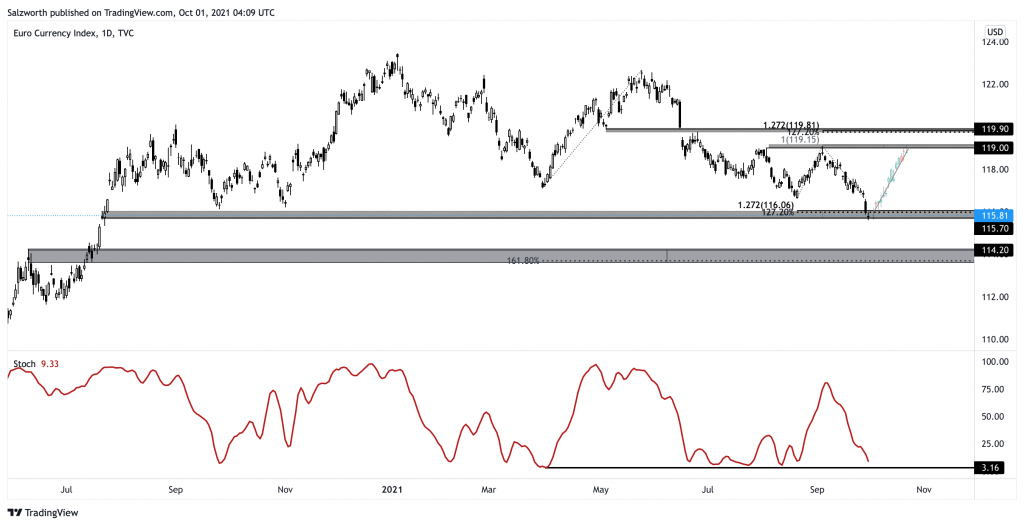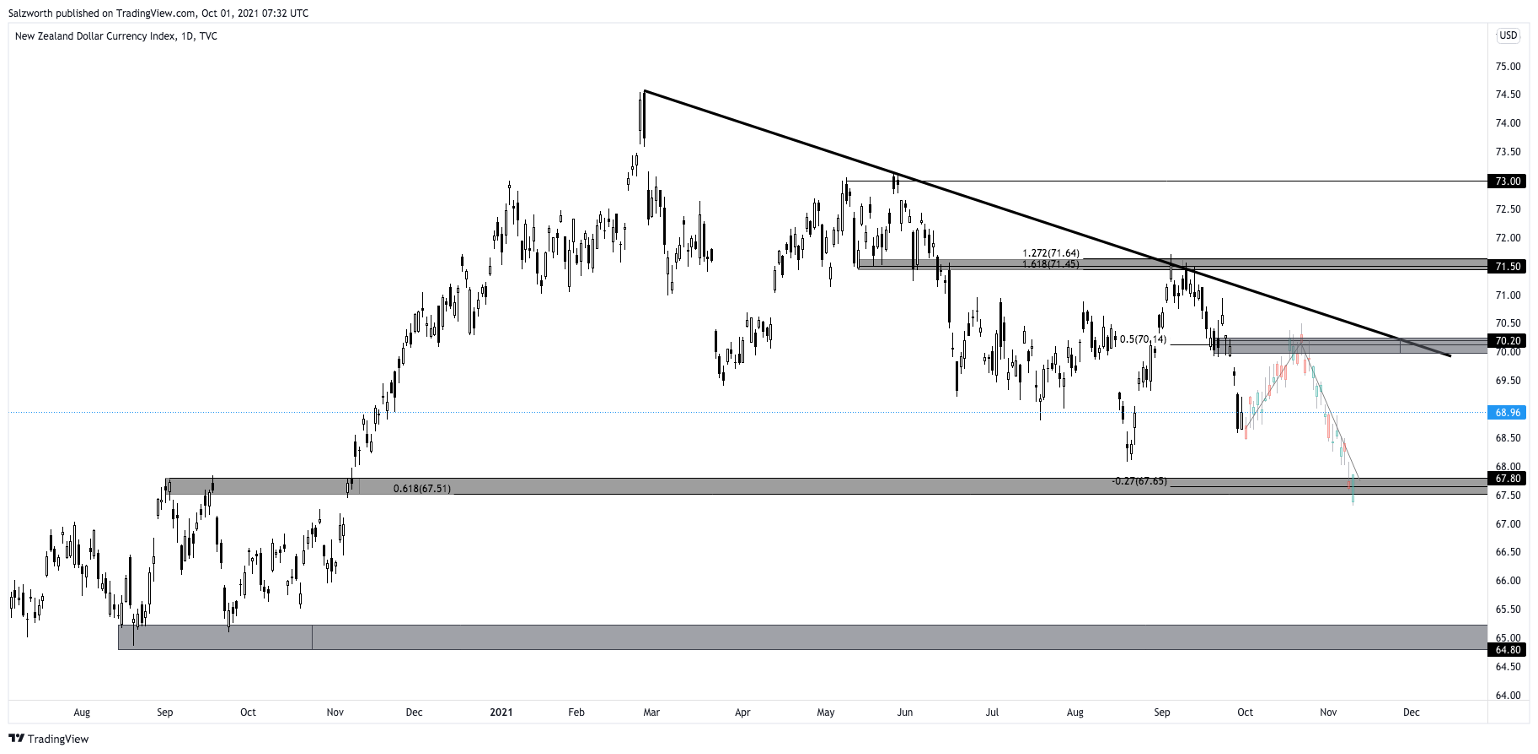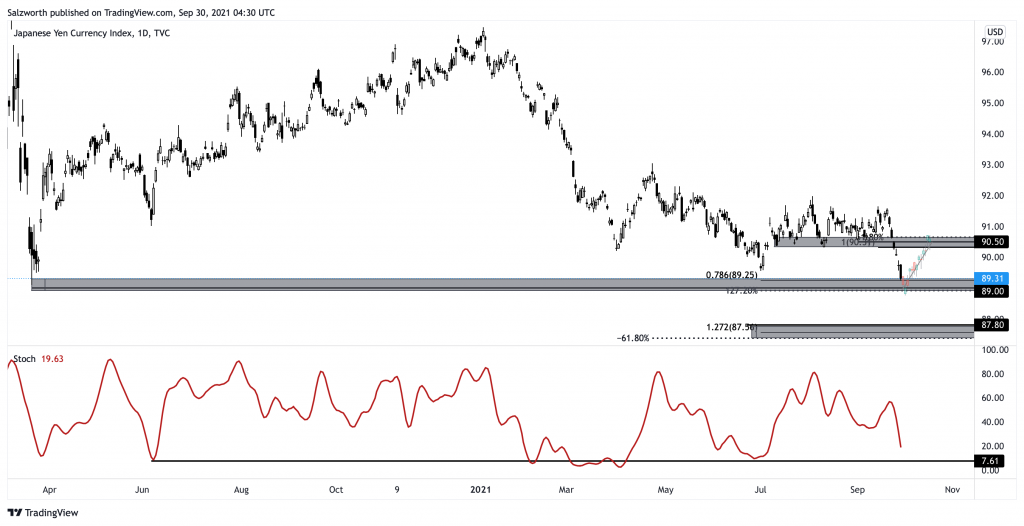
2021 October Outlook for G7 Currencies
2021 October Outlook for G7 Currencies
Dollar Currency Index: Bearish below 94.800
On the daily time frame, prices are testing the resistance zone at 94.800, which coincides with the graphical high, 127.2% Fibonacci retracement and 127.2% Fibonacci extension. Stochastics are also approaching resistance where price has reacted at before, adding confirmation to the short-term bearish scenario. We see an opportunity for a potential short-term reversal towards the 92.800 support area, which coincides with the ascending trendline support, which 61.8% Fibonacci retracement and 78.6% Fibonacci extension. 
DXY Fundamentals
The Dollar strengthened against its peers to its highest level since November 2020, after a month-long rally during September, amid the Fed turning more hawkish towards the end of the month. The Fed is expected to proceed with tapering of stimulus from November 2021, and a possible interest rate hike sometime in late 2022. However, Fed Chair Jerome Powell indicated that “supply bottlenecks in some sectors” could cause inflation to last longer than what the Fed had previously expected. That could erase some of the lustre from the greenback, where we could subsequently see a pullback on the Dollar Index. Additionally, given the prevailing risk-off sentiment in the market that has been persisting for a period of time now, demand for the safe-haven reserve currency may have already been priced in.
Moving forward into October, we could see a minor pullback on the dollar before a continued rally towards the upside, with the expectations of interest rate hikes sometime later in 2022. September’s nonfarm payrolls are expected to show an improvement to 500,000, after August’s dismal results at only 235,000. The upcoming results from the nonfarm payrolls will be closely monitored by investors, to have a clearer idea of how the U.S. jobs market is faring in this COVID-19 pandemic era.
Euro Currency Index: Bullish above 115.70
On the daily time frame, prices are trading near the horizontal swing low support in line with 127.2% Fibonacci retracement and 127.2% Fibonacci extension. Prices might see a bounce from the 115.70 level towards horizontal swing high resistance at 119.00, in line with 100% Fibonacci extension. Stochastics is also approaching the 3.16 level, showing potential for a bounce. If prices continue to push down, we might expect prices to trade sideways at 114.20 level, in line with horizontal pullback support in line with 161.8% Fibonacci retracement.

EUR Fundamentals
Euro dipped to below $1.17 against the greenback amid a stronger dollar after the Fed signalled interest rates may need to rise faster than initially expected. Eurozone annual inflation rate was confirmed at 3.0 percent in August 2021, the highest since November 2011 and well above the European Central Bank’s target of 2.0 percent. However, ECB officials and several policymakers have been dismissing the rising inflationary pressures as temporary, reaffirming their dovish stance in keeping interest rates at record low levels.
On the data front, industrial output in Eurozone rose by 1.5 percent from a month earlier in July 2021, reflecting the pickup in the Eurozone’s economy. Looking ahead in October, investors will be looking out for Eurozone news, especially at the end of the month with the release of ECB’s Interest Rates decision as well as Consumer Price Index data. A more dovish European Central Bank is expected as they maintain the stance that inflation pressures are “transitory”.
British Pound Currency Index: Bullish above 134.70
On the daily time frame, prices are generally facing a more bearish pressure. However, a bounce might be seen from 134.7 level which is in line with 127.2% Fibonacci retracement and 100% Fibonacci extension. Prices might experience a short push up towards horizontal pullback resistance in line with descending trendline resistance which also coincides with 61.8% Fibonacci retracement and 78.6% Fibonacci extension. If prices continue to push downwards, prices might take support at the 133.00 support zone, in line with the 161.8% Fibonacci retracement and 161.8% Fibonacci extension. Stochastics is also approaching its support level at 9.40, signalling potential for a bounce.

GBP Fundamentals
Sterling traded around $1.37, at the end of September after Bank of England’s (BoE) hawkish tone on its monetary policy. BoE lifted its forecast for inflation and two of its policymakers called for an immediate halt to the 895-billion-pound bond purchase programme, bringing forward expectations for an interest rate hike. Concerns on Britain’s economic recovery as well as the unemployment outlook capped the Sterling’s gains.
On the data front, consumer confidence in the UK fell 5 points to –13, the steepest decline since October 2020. Meanwhile, Bank of England’s downward revision of its Q3 growth along with the risk aversion witnessed in the markets continued to weigh down on the Pound. Yields on the UK 10-year government bond extended its surge, touching 0.96% in late September, the highest since March 2020. A bearish outlook for the Sterling looms as investors head into the month of October, while keeping a close watch on the Core CPI data towards the end of the month.
Australian Dollar Currency Index: Bearish below 74.20
On the daily time frame, prices reversed nicely below its graphical resistance zone at 74.20 and continue to face bearish pressure from its 21 period EMA, which acts as a dynamic resistance where we saw prices react and reversed below the 21 EMA multiple times. We maintain a bearish bias on AXY, with further downside seen to test our support zone at 71.20, which coincides with the 127.2% Fibonacci extension. A break below the 71.20 support zone could see prices push lower, with 69.80 as our next support zone target, in line with the 161.8% Fibonacci extension.

AUD Fundamentals
The Aussie extended its decline as the commodity currency took a hit from the risk aversion following Evergrande’s debt crisis which roiled global markets. Market risk sentiment remains sour as investors continue to monitor the conglomerate’s debts progress, with fear that its collapse could send shockwaves to the world’s financial system. In the first week of October, Evergrande Group missed a second bond coupon payment, renewing concerns over its ability to repay over $300 billion in liabilities.
Elsewhere, at RBA’s monetary policy meeting on 7 September, the central bank kept interest rates unchanged at a record low of 0.10% while reaffirming its commitment in maintaining the current accommodative monetary policy, at least until mid-February 2022, as the Delta outbreak and stricter measures continue to hamper Australia’s economic recovery. RBA also noted rising inflationary pressure is likely to be transitory as wage and price pressures remain subdued, with expectations of a rebound in the economy in the fourth quarter.
On the data front, Australia’s second quarter GDP reflected a pickup in the economic activities, recording a 0.7% growth ahead of its 0.5% growth expectations. Meanwhile, August’s unemployment rate fell to 4.5%, the lowest reading since November 2008 and a significant improvement from July 2020’s peak which stands at 7.4%. Coming October, investors will be keeping a close watch on the RBA interest rate decision on 5 October, where rates are likely to remain unchanged. That said, any signs of a potential shift from RBA’s current dovish stance or hints of a progressive tightening of its monetary policy could give Aussie a boost. Other notable publications include the CPI data and unemployment rate numbers as indications of how the economy is coping with this pandemic.
New Zealand Dollar Currency Index: Bearish below 70.20
On the daily time frame, prices reversed nicely below our key resistance at 71.50 with further downside seen. Currently, prices remain under pressure, holding well below our resistance zone at 70.20, in line with the 50% Fibonacci retracement and descending trendline resistance. A further drop could be seen towards the support zone at 67.80 which coincides with the 61.8% Fibonacci retracement. A break above the descending trendline resistance could see a further push up towards the next resistance zone at 71.50, in line with the Fibonacci confluences found at that area.

NZD Fundamentals
Kiwi extended its decline after RBNZ held off from raising rates in August following the lockdown announcement. The currency could see a further decline, weighed down by the risk aversion in the markets. The delta strain is causing a broadly stagnated Asia’s manufacturing activity in September, exacerbated by China’s waning momentum, production bottlenecks and electricity rationing.
On the data front, Westpac-McDermott Miller consumer confidence index in New Zealand fell by 4.4 points to 102.7 in the third quarter of 2021 from 107.1 in the previous quarter, the lowest reading since the third quarter of 2020 in the wake of the latest lockdown, reflecting household’s shaky confidence in New Zealand’s economic outlook amid the resurgence of the virus. Meanwhile, New Zealand’s trade deficit widened to NZD 2,144 million in August of 2021, the largest trade deficit on record as imports jumped 38.4 percent from a year earlier to an all-time high of NZD 6,495 million led by a rise in imports of vehicles, parts, and accessories. Exports edged down 0.9% to NZD 4,351 million, as August is a typical month of lower values for dairy exports.
Other notable publications include the second quarter’s GDP data which recorded a 2.8% growth, well ahead of the market’s 1.1% estimate as the brief trans-Tasman bubble provided a boost to tourism related industries such as transport, retail and accommodation. In October, traders will be keeping a close watch on RNBZ’s monetary policy meeting for a clear timeline on the next interest rates hike. Other notable publications include the ANZ consumer confidence data and CPI data released in the later half of October.
Canadian Dollar Currency Index: Neutral between 77.50 support zone and 88.20 resistance zone
In last month’s call, prices reversed nicely below our resistance area at 79.50 to reach our support zone target at 77.50. Looking at the daily time frame, prices are currently, trading between our resistance zone at 80.20 and support zone at 77.50 where we maintain a neutral stance.

CAD Fundamentals
Canadian Dollar dipped in September as the commodity currency’s performance took a hit from the wave of risk aversion amid signs of slowing growth and pandemic woes. Falling oil prices, caused by an unexpected increase in API crude oil inventories; a 4.127 million barrel increase in crude oil inventories for the week ended September 24th dragged the Loonie lower, as oil is one the Canada’s major exports. On the data front, the labour market is showing signs of picking up, the economy added 90,000 jobs in August, the third consecutive monthly increase, while the unemployment rate fell to 7.1 per cent for the month of August, from 7.5 per cent in July, bringing the rate to the lowest level since the start of the pandemic last year. In October, notable publications include the unemployment rate, retail sales, PMI, CPI and GDP data to give further insight as to how Canada’s economy is recovering from the pandemic.
Japanese Yen Currency Index: Bullish above 89.00
On the daily time frame, prices are testing support at 89.00, in line with the daily support zone, 127.2% Fibonacci retracement and 78.6% Fibonacci extension. We could see a short-term bounce above this support zone to the 90.50 support-turned-resistance zone, in line with the 61.8% Fibonacci retracement and 100% Fibonacci extension. Stochastics are also showing potential for a short-term bullish move as it approaches the support level where price has reacted before. However, a break below the support at 89.00, could see prices push lower with 87.80 as the next support target.

JPY Fundamentals
The Yen traded within a range for much of September but saw a sharp decline in late September. This was mostly against the strengthening U.S. dollar, causing the yen to lose its appeal amongst investors. Meanwhile, Japan’s ruling democratic party elected Fumio Kishida to be its next party leader, and he is expected to be sworn in as Prime Minister next week. Given Kishida’s inclination towards supporting the Japanese economy via expansionary fiscal policy, investors remain optimistic, but cautious, of his impact. Japan is also lifting its COVID-19 state of emergency on the last day of September, indicating possible optimism over its economic recovery that could bolster the strength of the Japanese Yen in the month of October.



